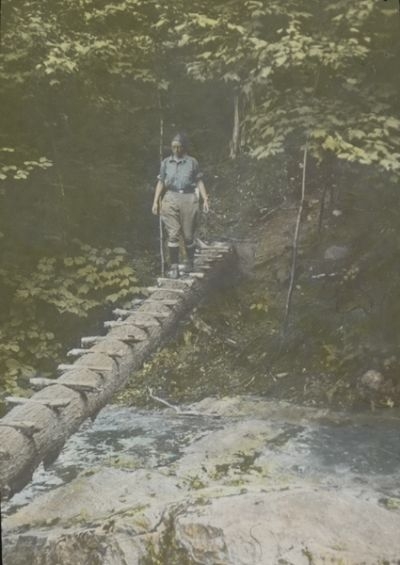Visit the Series Homepage
The Long Trail: Vermont’s Footpath Through History

(Host) All this week we’ve been looking at the history of the Long Trail as it reaches its 100th anniversary.
Today, we turn to the Green Mountain Club itself as we conclude this portion of our series.
Volunteer members of the club built the trail and they maintain it to this day.
As VPR commentator Tom Slayton explains, the club still thrives because of their efforts.
(Slayton) It took the Green Mountain Club twenty years to cut and clear the Long Trail over the tops of the Green Mountains from Massachusetts to Canada. But without the constant efforts of volunteers and trail workers, that trail, one of Vermont’s genuine treasures, would quickly disappear.
It was the first long-distance hiking trail in this country when it was established in 1910. And it is still regarded as one of the best. But as Green Mountain Club President Marge Fish notes, it has to be maintained every year, or the forest would soon take it back.
(Marge Fish) "I would say within at the most, three to four years, that much of the trail would be so overgrown that you would really need map and compass or a GPS route to find a lot of it. There are some sections where there hasn’t been quite as much loving maintenance done, for lack of volunteers working on that piece of trail, or for difficult accessibility, where it’s been a couple years before a major clipback, and it’s really hard, at times, to find the trail; and then it takes a big volunteer effort to get it clipped back adequately, to be seen."
(Slayton) The really amazing thing is that most of the thousands of hours of work required by the Long Trail is done by Green Mountain Club volunteers. Executive director Ben Rose says volunteers are a vital part of maintaining the trail.
(Ben Rose) "Nowadays, the existence of the Long Trail is an annual miracle of about 800 volunteers. The trail would disappear without all the hundreds of people who go out every year, all over the state, and clear blowdowns and clean the leaves out of the waterbars so that the trail drains properly, and maintain the trail shelters and privies. It’s a very grassroots organization."
(Slayton) A paid trail crew does the heavy lifting in the summer and this one is in training. The crews back up the volunteers, along with a year-round staff of ten. The workers build those stone staircases you often find in steep sections, rebuild old shelters and construct new ones. Their name is the Long Trail Patrol. And they’ve been improving the trail since 1931.
However, their goal is not to make the Long Trail easier. What they’re really aiming for, according to Field Operations Director Dave Hardy, is to keep the trail wild, rugged and pristine, a true "Footpath in the Wilderness."
(Dave Hardy) "The goal is to maintain a primitive hiking trail. It’s not supposed to be easy. And our goal is to keep it a wild experience in the woods, so we do address safety concerns with regard to the trail and we work to protect the resource, but we want it to be the same as it was when your parents hiked the trail, or when your grandparents hiked the trail. And we’re passing this along from one generation to the next."
(Slayton) So preservation of the mountain experience is one aspect of the work done by Green Mountain Club volunteers and the Long Trail Patrol. But sometimes they undertake projects that can only be called visionary.
(splashing water)
Take Thundering Falls on the Appalachian Trail, for example. It’s one of the highest and most beautiful waterfalls in Vermont, a foaming white cascade that dashes down over rock ledges to join the Ottauquechee River in a huge beaver meadow in the town of Killington.
Before the Long Trail Patrol crews and others went to work, the trail bypassed the waterfall and hikers had to skirt the beaver meadow and follow a gravel road. Over four summers, the crews built a half-mile boardwalk directly across that beaver meadow and a viewing platform directly facing Thundering Falls. While they were at it, they made everything handicapped accessible. The result is a walkway across a scenic marsh, ending at a spectacular waterfall that anyone, even those in wheelchairs, can get to and appreciate.
Proving, I guess, that trails can be tough, but the hearts of the Green Mountain Club’s volunteers and leaders don’t have to be.
(Host) Tom Slayton is editor emeritus of Vermont Life and editor of "A Century in the Mountains."
Our series was produced by Melody Bodette and edited by Ross Sneyd. Chris Albertine is the engineer. Theme music was composed and performed by Peter Engisch and other music was performed by Bob Merrill. John Van Hoesen is executive producer.
Next week, we conclude our look at the Long Trail’s 100th anniversary by heading out on the trail to hear from some hikers.